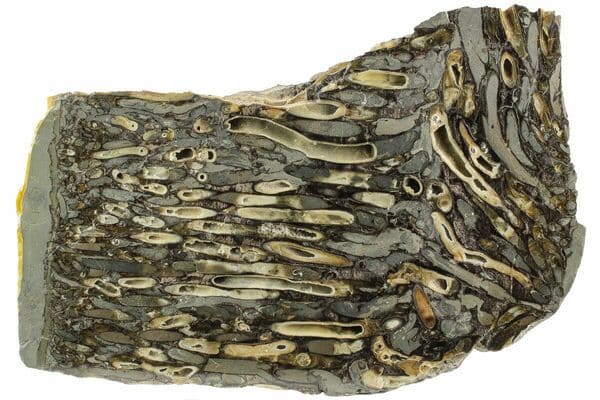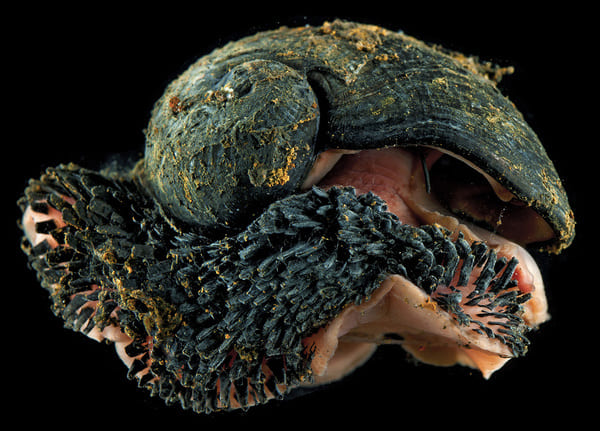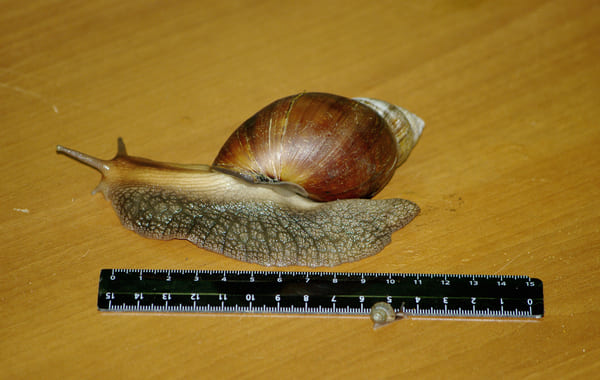In the animal kingdom, molluscs are unique, second only to insects. They are one of the largest animal groups on earth, with about 75,000 species. This large group has many unique abilities and characteristics. To show you this colorful group, we’re going to list the top ten molluscs in the world. There are the world's longest-lived mollusk (bright clam), the world's oldest mollusk (nautilus), the world's most beautiful mollusk (nautilus), the world's largest aquatic mollusk (king squid), The world's ugliest mollusk (shipworm) and more. I hope that through this article, you will gain a deeper understanding of molluscs, especially the most famous ones, and be amazed by their unique biological characteristics. Let's explore this biological world full of wonders together.

1. The world’s longest-lived mollusk (Ming Clam)
The bright clam, a mollusk belonging to the family Clams, enjoys the reputation of being the longest-lived mollusk in the world. People named it "Ming" because its existence spanned the Ming Dynasty in Chinese history. The creature lives on the seafloor in Iceland, and lines on its shell reveal it is over 507 years old, equivalent to more than half a millennium.
It is worth noting that the shell of the bright clam only grows in summer. Its growth environment must be warm and food-rich sea water. In such an environment every year, a new line will be formed on the shell of the bright clam, with a thickness of approximately 0.1mm. The thickness of each line on the clam shell depends on the environmental conditions at that time, thus revealing the marine ecological environment and climate changes that year. This makes the clam an important reference for understanding past marine environments and climate change.

2. The oldest mollusk in the world (Nautilus)
Nautilus, this ancient ocean dweller, as the oldest mollusk in the world, has evolved on the earth for hundreds of millions of years. Their form and habits have hardly changed much. Due to this characteristic, people often call them It is a "living fossil" in the ocean. Due to its unique historical location and biological characteristics, nautilus occupies an important position in biological evolution and paleontological research.
Nautilus has a pearly smooth and curly shell. The size of this shell can reach 26.8 cm in larger individuals. However, the average adult nautilus shell does not exceed 20 cm in length. In the remote Ordovician ocean, nautilus was a top predator, reaching an astonishing 11 meters in length. They mainly preyed on organisms such as trilobites and sea scorpions to sustain their own survival.

3. The most beautiful mollusk in the world (naked sea butterfly)
The naked sea butterfly, a creature belonging to the family Asteridae, is an elf of the cold deep sea. It lives at a depth of 350 meters in the Arctic Ocean and the Southern Ocean. It is known as the most beautiful mollusk in the world. This tiny creature is about two to three centimeters in length and is a type of planktonic mollusk. Uniquely, they are hermaphrodites and live mainly in the ice under cold seas such as the Arctic and Antarctic.
The body of the naked sea butterfly is completely transparent, and it is praised as the "Sea Angel" or "Ice Elf". The reason why they are called "sea angels" is probably related to their pair of wing-like organs. When they spread out their wings and swim in the sea water, the wings are like angel wings, dancing in the water, creating a magnificent picture of an angel in the water.

4. The world’s largest aquatic mollusk (king squid)
The giant squid is a creature that often lives in deep sea areas and is considered the largest aquatic mollusk on earth. Normally, king squids are about 8 to 10 meters long when they are young. However, when they reach adulthood, their body length can reach an astonishing 20 meters. It is worth mentioning that the king squid has shockingly large eyes, which can reach about 35 centimeters in diameter; and its suction cups are more than 8 centimeters in diameter.
The giant squid chooses to live in the deep sea and usually rests during the day. However, at night, they swim to the shallows of the ocean in search of food, mainly fish. In the dark waters, they use their superb hunting skills to catch prey.

5. The ugliest mollusk in the world (shipworm)
The shipworm is considered the ugliest mollusk in the world. In the sea environment, in addition to being susceptible to corrosion by marine organisms and microorganisms, the biggest threat to wooden ships comes from shipworms. Ship borers are marine organisms that are good at digging holes in wood. When they attach to wood, they can dig conical channels inside the wood and invade the interior of the wood. This type of passage has only a small hole connected to the outside world. If the external environment becomes unfavorable or is attacked by other marine organisms, the shipworm will quickly drill into the internal passage of the wood and secrete lime to seal the hole to resist attack by other organisms. Invasion.

6. The hardest mollusk in the world (Squama-horned gastropod snail)
The scaly-horned gastropod snail is known as the toughest mollusc species in the world. This creature lives near hydrothermal vents in the deep sea of the Indian Ocean. Their shells are covered with a large amount of iron disulfide and magnetic pyrite. These metal elements are mainly derived from mineral-rich vents. This hard shell provides the scaly-horned gastropod snail with an armor-like protection from predators, but it can also cause damage to creatures that attack it. The head of the scaly-horned gastropod snail has two smooth and tapered tentacles. They do not have eyes and specific communication organs.

7. The mollusc with the most teeth in the world (snail)
As an invertebrate, snails attract our attention with their peculiar characteristics. They are known as the molluscs with the most teeth in the world. A snail can have as many as 25,600 teeth. The entire snail body includes eyes, mouth, feet, shells, antennae and other parts. The spiral shells on their backs are unique and changeable, with different shapes, colors and sizes, including pagoda-shaped, gyro-shaped, and conical. There are various shell shapes such as spherical, spherical, and pipe-shaped.
As terrestrial shellfish molluscs, snails have lived on the earth for hundreds of millions of years. There are many kinds of snails. There are about 25,000 kinds in the world, distributed all over the world. There are thousands of kinds of snails in China, which fully proves the variety and wide distribution of snails.

8. The most poisonous mollusk in the world (blue-ringed octopus)
The blue-ringed octopus is known as the most venomous mollusk in the world. The toxin hidden in its body is so powerful that it can kill 26 adults in half an hour. This small creature is only about the size of a tennis ball. Even if its tentacles are fully extended, they are only 200 mm long. Like most octopuses, the blue-ringed octopus mainly makes a living by hunting small shrimps, crabs and small fish.
They have a unique way of hunting. They will wait for opportunities to attack their prey, paralyze the prey by biting and injecting poison, and then use their beaks to tear the prey into small pieces for consumption, or bite through the exoskeleton of hard-shelled animals and directly suck the meat juice. . blue circleOctopus is mainly distributed in the waters of Australia, New Guinea, Indonesia and the Philippines.

9. The world’s largest terrestrial mollusk (African giant snail)
The African giant snail is a medium-to-large terrestrial snail and the largest terrestrial mollusk in the world. The shell of this snail is very large, with a body length of generally 7-8 cm, up to 20 cm, and a weight of 32 grams. Their shells are long and narrow, tapered, with a ratio of shell length to shell width of about two to one. The shell of the African giant snail is slightly thick, smooth and has a long egg shape.
Food comes from a wide range of sources. They will eat crops, trees, fruit trees, vegetables, flowers and other plants. Sometimes when food is in short supply, they may also eat paper or even the corpses of the same species. Surprisingly, giant African snails can even chew and digest cement. Because of their wide food range, they are potentially damaging to more than 500 types of crops.

10. The smartest mollusk in the world (octopus)
Octopus is known as the most intelligent mollusk in the world. Their body is shaped like a short, egg-shaped pouch, without fins, and the line between head and trunk is unclear. The head of an octopus is usually between 7 and 9.5 centimeters. The head is equipped with large compound eyes and 8 retractable tentacles.
Octopuses are considered to have "conceptual thinking" and can solve complex problems independently. It is precisely because of this ability that they can even walk on two legs. The only similarity between octopuses and humans is their wide eyes. However, they differ significantly from humans in other ways: octopuses have three hearts, two memory systems, 500 million neurons in their brains, and some very sensitive chemical and tactile receptors. This unique neural structure gives it a thinking ability that exceeds that of ordinary animals.
The top ten molluscs in the world are mainly recommended based on the body shape, appearance, abilities and other relevant information of each mollusc, and comprehensively refer to the relevant Internet ranking lists. The list is for reference only to help you understand which molluscs are the best in the world. If you have any questions, please leave comments and criticisms at the end.
animal tags: Mollusk
We created this article in conjunction with AI technology, then made sure it was fact-checked and edited by a Animals Top editor.